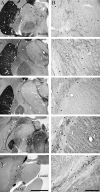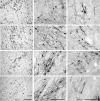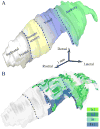Circuits formultisensory integration and attentional modulation through the prefrontal cortex and the thalamic reticular nucleus in primates
- PMID: 18330211
- PMCID: PMC2855189
- DOI: 10.1515/revneuro.2007.18.6.417
Circuits formultisensory integration and attentional modulation through the prefrontal cortex and the thalamic reticular nucleus in primates
Abstract
Converging evidence from anatomic and physiological studies suggests that the interaction of high-order association cortices with the thalamus is necessary to focus attention on a task in a complex environment with multiple distractions. Interposed between the thalamus and cortex, the inhibitory thalamic reticular nucleus intercepts and regulates communication between the two structures. Recent findings demonstrate that a unique circuitry links the prefrontal cortex with the reticular nucleus and may underlie the process of selective attention to enhance salient stimuli and suppress irrelevant stimuli in behavior. Unlike other cortices, some prefrontal areas issue widespread projections to the reticular nucleus, extending beyond the frontal sector to the sensory sectors of the nucleus, and may influence the flow of sensory information from the thalamus to the cortex. Unlike other thalamic nuclei, the mediodorsal nucleus, which is the principal thalamic nucleus for the prefrontal cortex, has similarly widespread connections with the reticular nucleus. Unlike sensory association cortices, some terminations from prefrontal areas to the reticular nucleus are large, suggesting efficient transfer of information. We propose a model showing that the specialized features of prefrontal pathways in the reticular nucleus may allow selection of relevant information and override distractors, in processes that are deranged in schizophrenia.
Figures









References
-
- Abramson BP, Chalupa LM. The laminar distribution of cortical connections with the tecto- and cortico-recipient zones in the cat's lateral posterior nucleus. Neuroscience. 1985;15:81–95. - PubMed
-
- Alexander GE, Fuster JM. Effects of cooling prefrontal cortex on cell firing in the nucleus medialis dorsalis. Brain Res. 1973;61:93–105. - PubMed
-
- Arnsten AF, Li BM. Neurobiology of executive functions: catecholamine influences on prefrontal cortical functions. Biol Psychiatry. 2005;57:1377–1384. - PubMed
-
- Asanuma C. GABAergic and pallidal terminals in the thalamic reticular nucleus of squirrel monkeys. Exp Brain Res. 1994;101:439–451. - PubMed
Publication types
MeSH terms
Grants and funding
LinkOut - more resources
Full Text Sources
